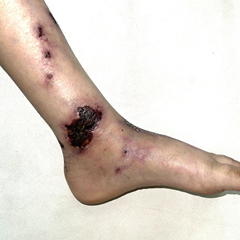(BMJ)—A 15-year-old boy had painful, itchy nodules on his legs and hands. The nodules progressed to ulcers over 1mo. PMHx: juvenile idiopathic arthritis, hypothyroidism, hyperphosphatemia. Meds: prednisolone, MTX, levothyroxine, sevelamer. Exam: indurated nodules with ulcers. Labs: elevated CRP, ESR, phosphorus (PO4). What’s the dx?

|
Ecthyma gangrenosum
|
|
Calciphylaxis
|
|
Sevelamer drug reaction
|
|
Mycobacterium leprae infection
|
|
Antiphospholipid syndrome
|
